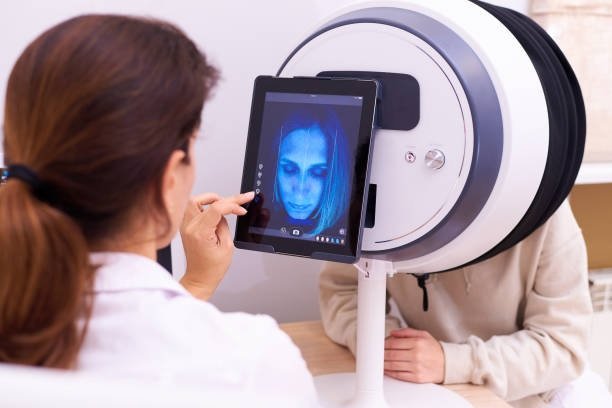Skin health is at the forefront of modern skincare treatments and with the rise of technology, skin diagnostic machines have become invaluable tools in skincare clinics around the world. These advanced devices help professionals assess the condition of the skin in a more accurate, detailed and non-invasive way. One such innovation is the Eve V Skin Diagnostic Machine – 3D Facial Recognition, which provides an in-depth analysis by scanning the skin and creating a 3D model for precise insights. By leveraging cutting-edge technology, skin diagnostic machines are transforming how skincare is approached and how treatments are tailored to individual needs. Here’s a closer look at how these machines are revolutionising skincare clinics.
The Role of Skin Diagnostic Machines
Skin diagnostic machines provide a comprehensive analysis of the skin’s health, which can be difficult to assess with the naked eye. These devices utilise a range of technologies such as high-definition imaging, infrared light, and even artificial intelligence to evaluate various aspects of the skin. From detecting underlying issues like dehydration and pigmentation to identifying deeper skin problems such as sun damage or wrinkles, skin diagnostic machines offer an in-depth look at skin health.
These machines capture images or data that go beyond what is visible on the surface, enabling skincare professionals to understand their clients’ skin conditions more thoroughly. This information allows for a more personalised and effective treatment plan, ensuring that treatments are precisely targeted to each individual’s unique skin needs.
How Skin Diagnostic Machines Work
Skin diagnostic machines use a combination of sophisticated technology and imaging techniques to assess skin conditions. For example, some devices employ spectrophotometry, which measures the reflection of light off the skin to determine moisture levels, pigmentation and sun damage. Others use ultrasound or infrared technology to examine the deeper layers of the skin and detect issues that may not be visible on the surface.
AI-powered machines can analyse these images in real-time, offering instant feedback to the clinician. This allows for a faster and more accurate assessment of the skin’s condition, enabling immediate action. The data collected can be used to track changes in the skin over time, which is especially useful for patients undergoing ongoing treatments for conditions like acne or ageing.
Benefits of Skin Diagnostic Machines for Skincare Clinics
- Personalised Treatment Plans
One of the key benefits of skin diagnostic machines is the ability to create highly personalised treatment plans. By obtaining a detailed analysis of the skin’s condition, professionals can recommend targeted treatments that address specific concerns. Whether it’s acne, pigmentation, or fine lines, the data gathered helps create a customised approach for each patient, ensuring they receive the best possible care. - Early Detection of Skin Issues
Many skin issues, such as sun damage or early signs of ageing, can be difficult to detect without advanced technology. Skin diagnostic machines help identify these problems early, allowing for preventative treatments to be put in place. Early detection can prevent more serious skin concerns down the line and promote healthier skin in the long term. - Accurate Monitoring of Skin Progress
Skin diagnostic machines can be used to track the progress of treatments over time. By regularly assessing the skin, skincare professionals can gauge the effectiveness of ongoing treatments and adjust them as needed. This real-time feedback is essential for ensuring that clients receive the best possible results from their skincare regimen. - Non-Invasive Analysis
Traditional skin analysis methods, such as biopsies or manual examination, can be uncomfortable and invasive. Skin diagnostic machines, on the other hand, offer a completely non-invasive way to assess the skin. This makes the process more comfortable for clients while still providing highly accurate results. - Enhanced Client Satisfaction
The detailed analysis provided by these machines helps to build trust between the skincare professional and the client. Clients are more likely to feel confident in the recommended treatments when they can see the data backing up the professional’s advice. This transparency helps improve client satisfaction and encourages long-term relationships with the clinic.
Types of Skin Diagnostic Machines
There are various types of skin diagnostic machines available, each designed to focus on different aspects of the skin. Some of the most common types include:
- Multi-Spectral Imaging Devices: These machines capture high-definition images of the skin’s surface and deep layers. They assess moisture levels, pigmentation, and overall skin health.
- Ultrasound Devices: Ultrasound technology is used to examine the deeper layers of the skin, which can help identify underlying issues such as skin elasticity or subcutaneous fat.
- 3D Skin Scanners: These machines provide a detailed, 3D map of the skin’s surface, allowing for a more thorough examination of wrinkles, pores and other skin imperfections.
- AI-Powered Devices: Artificial intelligence can be integrated with skin diagnostic machines to analyse skin conditions with remarkable precision. These devices can evaluate large amounts of data quickly, offering insights that may not be visible to the human eye.
The Future of Skin Diagnostic Machines
As technology continues to advance, the capabilities of skin diagnostic machines are expected to grow even more sophisticated. In the future, we can expect to see even more precise and accurate tools that incorporate AI, machine learning, and even augmented reality (AR). These innovations will further improve the ability to diagnose skin conditions, personalise treatments and monitor results over time.
Additionally, with the rise of at-home skincare, we may see more compact and user-friendly skin diagnostic devices becoming available for consumers. This would allow individuals to assess their skin regularly and take proactive steps in their skincare routine before visiting a clinic.
Conclusion
Skin diagnostic machines are revolutionising the way skincare clinics operate by providing detailed and accurate assessments of skin health. By using advanced technologies such as AI, multi-spectral imaging, and ultrasound, these machines enable professionals to offer more personalised, effective and non-invasive treatments. As these devices continue to evolve, we can expect even greater advancements in the skincare industry, offering both professionals and consumers smarter, more efficient ways to achieve and maintain healthy, radiant skin.















